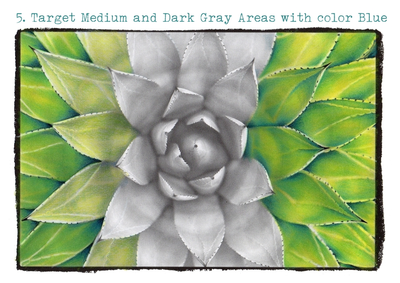
Colorist: Jones Flores
Coloring Book: Beautiful Nature When coloring grayscale there are 5 essential steps to follow for success:
These steps can be followed for any grayscale image you color. In order for you to see these steps in action, in this post Jones Flores has outlined how she followed these steps for the succulent you see above. Below you will find a coloring worksheet for the succulent as well as a color chart and an image progression of Jones' coloring process from start to finish so that you can try out the steps and follow along with Jones' process. Download the Coloring Worksheet
Download & print this grayscale coloring worksheet for the succulent from Beautiful Nature so you can color along with Jones' guidance.
Step 1: Choosing Colors Using the 3 Tone Rule
To simplify grayscale coloring we have classified it into 3 major areas: light, medium and dark. To assist with your color selection, Jones developed the 3 Tone Rule. The 3 Tone Rule is choosing 3 shades of the same color for each color you plan to use in your picture. To see how this works, here are the color selections Jones made for the succulent:
The major color is Green so Jones picked:
To enhance her palette, Jones chose Blue to increase the contrast which applies for the shadows. Again, by applying the 3 Tone Rule, Jones chose the following for her Blues:
Additional colors would be for highlighting and shadowing.
Prismacolor Premier Color List for the Succulent To find the Faber Castell Polychromos equivalents, check out this awesome Prismacolor/Polychromos pencil comparison chart created by Claire of Colour with Claire. 
Step 2: Layering
In order to build up color intensity and depth it is important to do many light layers of colored pencil. Apply your layers using light pressure and a circular motion.
Step 3: Increasing Contrast
Shadowing, outlining and highlighting are key to increasing contrast. By focusing on shadowing and outlining the existing highlights will intensify due to the increased contrast that has been created.
Highlighting: Add further layers to your brightest areas to ensure they are as bright as possible.
TIP: Colored Pencils are not as opaque as wet mediums like paint or ink pens and it is always a challenge to bring out the brightness of light colors. Shadowing: Add layers using the 3 shades of Blue. However, this time only target the medium and dark gray areas of the leaves. Using one tone at a time:
Outlining is a process to define the shadows by creating thin lines using the color of the shadow.
Step 4: Blending
There are many options for blending as outlined below. For the succulent, Jones burnished with Creme for the light areas and Grass Green on the medium areas. Jones did not burnish the dark areas she just left them as is after lots of layering. If you do wish to burnish the dark areas then do so with Grass Green after applying multiple layers of Green and Blues mixed with Black.
TIP: Tooth of the paper is the nooks and crannies you see when you apply your colored pencils and find a grainy texture. That texture results when the pigments of the colored pencils are not able to reach the tooth of the paper. Circular motion pencil strokes help the pencils to get into the nooks and crannies which results in smoother blending and output. Step 5: Finishing Touches
Once the layering, shadowing, outlining & blending are complete it is now time to apply any finishing touches. Depending on the picture you are coloring, it can be anything from tiny white dots with white ink pen on the brightest spots in your picture to a sharp black pencil to add flecks of dark detail like in this succulent. The small finishing touches are what can truly complete a picture and take it to that more realistic level.
The Full Process
Here are the 10 stages of coloring the succulent that Jones advanced through. These stages embody the 5 steps outlined above: choose colors, layer, increase contrast, blend and finish.
Happy Coloring!
Get Grayscale Coloring Tips & Tutorials Delivered to Your Inbox
Make sure to sign up for our newsletter to receive coloring tips, techniques, tutorials & coloring worksheets to your inbox.
More Coloring Tutorials
How to Color Grayscale Water: Waves Big & Small
How to Color Grayscale with Colored Pencils: the Basics Coloring the Iguana: Step-by-Step to Realistic Results Tutorial & Color-Along #4: Flamingos Tutorial & Color-Along #3: Lotus Flower Buds Tutorial & Color-Along #2: a Grayscale Landscape Tutorial & Color-Along #1: a Grayscale Cat Coloring Water Drops How to Paint a Sunset and Reflection Layering and Burnishing Painting Peony Buds with Acrylics Using Prismacolor Premiers to Color Magnolia Tree Flowers Using Soft Pastels Blended with Baby Oil to Color the Succulent
Teri
10/5/2017 05:55:18 pm
I'm excited to see this. YAY! Something new to start on. I haven't been able to get the ocean wave. I just can't get that one right. Now, I can set it aside and go back to it later and try again. Comments are closed.
|
||||||










